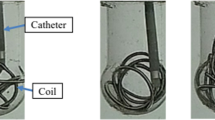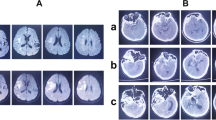Summary
254 consecutive cases of angiographically demonstrated intracranial cerebral aneurysms occuring over a three year period were reviewed with specific reference to aneurysm multiplicity, site, patient age and the presence of infundibular abnormalities. The overall incidence of multiple aneurysms was 44.9%. Female patients accounted for 66.5% of all aneurysm cases. The incidence of multiplicity was higher in women (51.5%) than men (31.7%) and overall was higher in patients over 40 years of age (52.8%) compared to those under this age (26.3%). Infundibula occured in 27.2% of all patients and 9.45% of all patients demonstrated infundibular dilatation of the origin of the posterior communicating artery.
Similar content being viewed by others
References
Hamby WB (1959) Multiple intracranial aneurysms. Aspects of treatment. J Neurosurg 16:558–563
McKissock W, Richardson A, Walsh L, Owen E (1964) Multiple intracranial aneurysms. Lancet I:623–626
Heiskanen O (1965) Multiple intracranial arterial aneurysms. Acta Neurol Scand 41:356–362
King G, Slade HW, Campoy F (1954) Bilateral intracranial aneurysms. Arch Neurol Psychiaty 71:326–336
Ostergaard JR, Hog E (1985) Incidence of multiple intracranial aneurysms, influence of arterial hypertension and gender. J Neurosurg 63:49–55
Sengupta RP, McAllister VL (1986) Subarachnoid haemorrhage. Springer, Berlin Heidelberg New York, p 143
Ebina K, Ohkuma H, Iwabuchi T (1986) An angiographic study of incidence and morphology of infundibular dilatation of the posterior communicating artery. Neuradiology 28: 23–29
Paterson A, Bond MR (1973) Treatment of multiple intracranial arterial aneurysms. Lancet I:1302–1304
Artiola i Fortuny IL, Adams CBT, Briggs M (1980) Surgical mortality in an aneurysm population: effects of age, blood pressure and preoperative neurological state. J Neurol Neurosurg Psychiaty 43:879–882
Yoshimoto T, Uchida K, Kaneko U, Kayama T, Suzuki J (1979) An analysis of follow up results of 1000 intracranial saccular aneurysms with definitive surgical treatment. J Neurosurg 50:152–157
Poppen JL, Fager CA (1959) Multiple intracranial aneurysms. J Neurosurg 16:581–589
Saltzman GFR (1959) Infundibular widening of the posterior communicating artery. Acta Radiol 51:415–421
Sengupta RP, McAllister VL (1986) Subarachnoid haemorrhage. Springer, Berlin Heidelberg New York, p 195
Kayembe KNT, Sasahara M, Hazama F (1984) Cerebral aneurysms and variations in the circle of Willis. Stroke 15:846–850
Sengupta RP, McAllister VL (1986) Subarachnoid haemorrhage. Springer, Berlin Heidelberg New York, p 120
Stunz JT, Ojemann GA, Alvord EC (1970) Radiographic and histologic demonstration of an aneurysm developing on the infundibulum of the posterior communicating artery. J Neurosurg 33:591–595
Fox JL, Baiz TC, Jakoby RK (1964) Differentiation of aneurysm from infundibulum of the posterior communicating artery. J Neurosurg 21:135–138
Author information
Authors and Affiliations
Rights and permissions
About this article
Cite this article
Wilson, F.M.A., Jaspan, T. & Holland, I.M. Multiple cerebral aneurysms — a reappraisal. Neuroradiology 31, 232–236 (1989). https://doi.org/10.1007/BF00344349
Received:
Issue Date:
DOI: https://doi.org/10.1007/BF00344349




